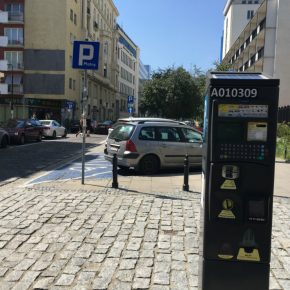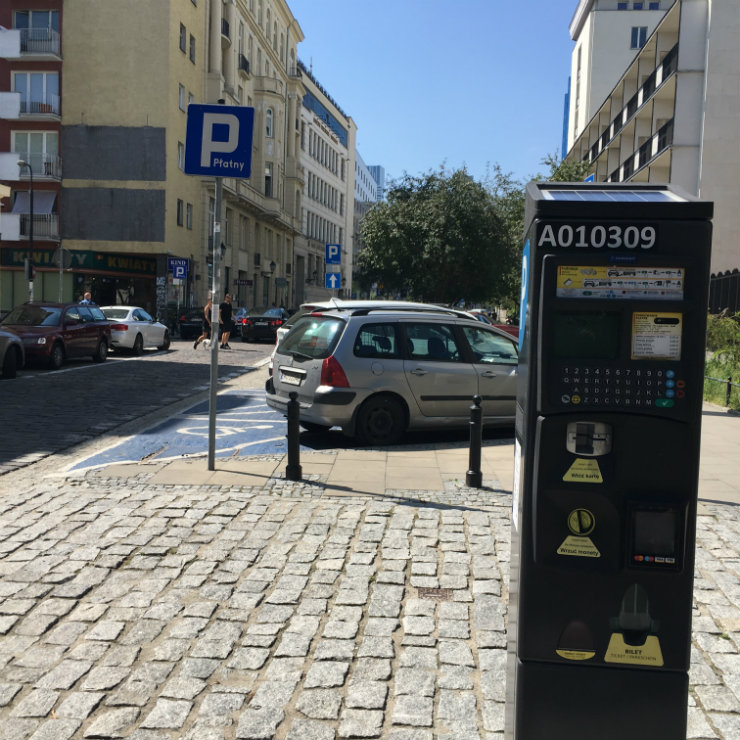Tydzień w gospodarce
Category: Trendy gospodarcze

Paid parking in the center of Warsaw, Poland (Maria Bninska, Public domain)
This is a global problem. In Poland is even more acute, because Polish cars are old, so they cause more problems. They also do harm even when they are parked, because even not used generate costs.
Poland is one of the most motorized countries in Europe. The available statistical data are not entirely up to date, but they accurately reflect reality, as big changes in this field occur relatively slowly. If we were to leave out the smallest countries, then according to the ACEA (European Automobile Manufacturers’ Association), in 2014 among European states only the Italians (610) and Germans (550) exceeded Poland in terms of the number of passenger cars per 1000 inhabitants. The distance separating Poland from these countries is small, however, since Polish figure is 526. In this respect the Poles are ahead of much wealthier societies such as the British (507), the Belgians (492), the Dutch (487) and the French (483).
Even if the number of cars actually “in use” in Poland is indeed overestimated due to errors in the database, this does not change the fact that Poles love affair with cars is clearly out of proportion compared to their level of wealth and the disastrous condition of the environment.
The cars driving in Poland are a lot younger than horse-drawn carriages, stage coaches and wagons, but nonetheless they are old. Last year as many as a million of used passenger cars and delivery trucks were brought to Poland. Their average age was 11 years and 10 months, so the technical condition of these automobiles could not be very good. One small consolation could be found in the fact that a certain percentage of these cars is sold beyond the eastern borders of Poland, immediately after “restoration” in the car workshops operating in the shadow economy.
On the other hand, a growth in sales of luxury vehicles is observed, which are getting bigger and more powerful with each new model. The number of premium cars sold in 2016 reached approx. 50,000, i.e. about 1/3 more than the year before. Interestingly, the everyday snapshot of the streets in Warsaw, Poland’s capital suggests that the increasingly popular large SUVs are used to a great extent as a surrogate of a sedan car.
We can reasonably speculate that the use of cars in Poland is rarely a necessity and a matter of calculated choice, and all too often an expression of the need to emphasize success and status. Of course, there is also the element of convenience provided by the use of cars for the daily commute. In the case of automobiles, however, their convenience fades along with their popularization, and, additionally, along with the increasing number of cars the price of comfort grows more than proportionally.
Firstly, there are the huge costs of the construction and maintenance of the constantly improved road infrastructure. These costs are borne individually and directly in the form of taxes and charges arising from the possession and use of a car, but above all, without any relation to the ownership or use of a vehicle, i.e. as part of the so-called collective consumption financed from the most important taxes by the central government and the local authorities. Collective consumption does not merely include directly related items such as the construction, repair, and maintenance of roads, streets and parking spaces. We should also add the huge costs of removing environmental damage, the treatment of sick people suffering from the high concentrations of exhaust fumes and smog, the treatment of the victims of accidents, etc.
Secondly, the more cars drive on the roads, the more difficult it becomes to fulfil the needs for which they were invented.
In mid-April this year, the Voivodeship Administrative Court in Warsaw ruled on the requirement to provide the registration plate numbers in order to receive a ticket from the parking meters. The (non-final) judgment states, that the resolution of the City Council of the Warsaw forcing drivers to provide their registration number was issued in violation of the law. The judges did not, however, respond to the argument that the provision of the registration number could be used to track citizens, but only assessed the violation of the procedure for issuing legal acts. Of course, the plaintiffs did not really care about the alleged spying, which could be effectively avoided by not driving one’s car into the city center, but wanted to make it more difficult for the authorities to enforce the payment of the parking fees.
The resistance of a large number of citizens against any attempt to rationalize the use of cars in the city is very strong and therefore generates political fear at all levels of the three branches of the Polish government. Car manufacturing is also a big part of the economy. The ACEA estimates that while employment in the EU directly and indirectly related to the automotive sector decreased slightly, in 2011 it still amounted to 12.7 million (compared with 13.4 million in 2008).
The particular interests of car companies also matter. All developed countries, excluding large parts of the German motorways, apply relatively restrictive speed limits for cars on their roads and streets. Meanwhile, the average power and dimensions of the cars, which are after all intended not for sports racing but for driving in cities and villages, is increasing with each year. We can only drive faster than 100 km/h in certain places, but both the manufacturers and drivers seem to be interested in cars going 170-180 km/h and more.
Let’s look at the annual costs of driving a medium-class car (purchase price of EUE14,080) in the city. Assume a total driven distance of 15,000 km, fuel consumption of 8 liters/100 km (traffic lights, traffic jams, winter), price of a liter at fuel of EUR1.06, driver’s insurance at EUR352, parking costs of EUR234.67, expenditure on the vehicle’s operation and repairs – EUR469.34, and depreciation over 10 years (all items given in annual terms) minus the residual value of EUR1,173.36, the cost of 1 kilometer driven with an owned car is EUR0.24. With these assumptions, the annual cost of using a car is EUR3,613.93. A public transit pass in Warsaw costs less than EUR281.61 per year.
If we were to narrow the calculation down to the commute to and from work, and the driven distance to 20 km on every working day, then during one year we will barely drive 5,200 km, and the cost of 1 kilometer will grow to EUR0.54 and will match the rates of taxi corporations.
According to another calculation, the average car is driven 15,000 kilometers per year. If the average speed is 40 km/h, then the average time spent driving a car in one year will be 375 hours, that is approx. half a month. From this perspective, we statistically use a car for one full day once every 24 days, which is very rare. It is therefore true that cars mainly stand still rather than drive, but we can’t really see this on the streets of Polish cities. If we are to avoid a disaster it would be better if they stayed parked after all, but not for free.
The hourly parking rate in Warsaw (EUR0.7) is lower than the price of the cheapest public transit ticket – EUR0.8 for a 20-minute ride. The annual subscription for people living in the paid parking zone costs EUR7 per year. If such a person was paying the full price, then the annual cost of the 10 paid hours per day would give a total of EUR1,947.54 (EUR7.46 x 261 weekdays in a year). However, in Poland’s reality the inhabitants of the more remote parts of the city subsidize the parking of cars belonging to people living in the center, who could easily walk to work or to the cinema.
We shouldn’t be subsidizing the inhabitants of city centers through dirt cheap parking passes because such a location is already a privilege in itself. The prices of apartments in the center of Warsaw start from around EUR2,346.71 per square meter and only go up from there, so we are not talking about poor people.
On the other hand, it is inappropriate and downright wrong to formulate radical proposals. Eliminating cars from the centers of Polish cities in the perspective of less than a decade seems to be an unrealistic proposal, but we could imagine gradually pushing them away from the city center districts. A necessary condition for this, although not sufficient on its own, would be a significant increase (at least doubling) of the hourly parking rates.
The streamlining of the control of payments necessary in this scenario, could be modelled, for example, on Amsterdam, which is controlled by cars with scanners reading signals from the tickets and parking cards (with the vehicle’s registration numbers) and the parking meters. When a car is parked longer than allowed, or if the fee is not paid, the scanner sends a signal to a guard cruising on a moped, who already knows the amount of penalty to be handed out. In 2015 Amsterdam obtained EUR190m from parking fees.
Warsaw has about three times more inhabitants than Amsterdam, and counting per capita we have at least as many cars driving as that city. Therefore, if we were to decide that parking is different from breathing, and does not have to be free or very cheap, then the proceeds from these fees could be many times higher than today.
In 2015 Warsaw only collected EUR19.64m from parking fees (including EUR2.96m from penalty fees). If we were to follow Amsterdam’s proportions, but account for the differences in incomes by converting EUR to PLN, the proceeds for the capital could reach EUR140.8m per year. This money would enable us to further improve and expand the public transportation system. The word “further” is absolutely appropriate in this case, because the improvement has been pretty dramatic, compared with the year 2004, when Poland became a member of the EU.
In Warsaw, the gross costs of public transportation amount to EUR633.6m per year, and the net costs, i.e. minus the proceeds from the tickets, amount to EUR445.9m. The additional EUR117.3m a year from parking fees (reached over time) could help in closing a part of the financial deficit of the municipal transportation system.
Because cars are mostly used by the older generation, free or disproportionately cheap parking constitutes a subsidy for the older people paid out of the pockets of young people.
The deadly impact of large numbers of cars on the air is now widely understood and does not need to be further debated. It’s enough to live in a city without industry and domestic boiler rooms, and see how much dust gathers on the floor and the furniture already on the second day after a thorough cleaning. On the other hand, the automobile is still the symbol of modern times and the great global economic success of the years following World War II.
In addition to the immediate measures, such as the increase in parking fees, along with the progress in the field of ICT it will be possible to raise the fee for driving into the city and the city center alone and using a disproportionately large car which was built for purposes other than merely commuting to the office. Revenues obtained this way should be used on the development and improvement of all forms of public transport.
Taxis are a good solution for people who like convenience. That is why we should not fight against Uber and similar projects, but try to sensibly reduce the formal requirements for licensed taxi drivers and then extend them to all the other people involved in the commercial carriage of passengers. Activity of this nature could be subject to tax preferences provided that fares will be charged (and recorded online by the tax authorities) exclusively by electronic means (cards, smart phones, internet transfers, and whatever else they come up with).
The hope for a marked improvement in the quality of air in the cities over the next couple of decades can be linked with electric vehicles. The potential consequences of the introduction of autonomous electric cars, i.e. ones without a driver, are more ambiguous. We hear about visions of vehicles arriving right on time exactly at our doors based on data about our habits and signals that we are about to go out. This perspective seems great, but its implementation would mean renewed congestion of the streets with cars, and especially the use of something equivalent to a wheelchair by the majority of the population.
Limiting car traffic in cities is also an issue of urban planning and legislative solutions. In the very center of the Polish capital and other Polish cities there are countless empty plots of land and ruins that should be demolished. The cities, however, do not have the funds to buy them out, to develop the parcels, and then to resell them for the purposes (among others, housing), which they themselves established in the zoning plans.



